| Carbon dioxide | |
|---|---|
| IUPAC name | |
| Other names | Carbonic acid gas Carbonic anhydride Dry ice (solid) |
| Identifiers | |
| CAS number | 124-38-9 |
| PubChem | |
| EC number | |
| UN number | 1013 (cylinder) 1845 (solid) 2187 (liquid) |
| RTECS number | FF6400000 |
| SMILES | |
| InChI | |
| ChemSpider ID | |
| Properties | |
| Molecular formula | CO2 |
| Molar mass | 44.0095(14) g/mol |
| Appearance | colorless gas |
| Density | 1,600 g/L (solid) 771 g/L (liquid) 1.98 g/L (gas) |
| Melting point | −56.6 °C (216.6 K) −69.9 °F |
| Boiling point | −78.5 °C (194.7 K) −109.3 °F (subl.) |
| Solubility in water | 1.45 g/L (25°C, 100kPa) |
| Acidity (pKa) | 6.35 and 10.33 |
| Viscosity | 0.07 cP at −78 °C |
| Dipole moment | zero |
| Structure | |
| Molecular shape | linear |
| Hazards | |
| MSDS | External MSDS |
| MSDS | ICSC 0021 |
| EU Index | Not listed |
| Flash point | Non-flammable |
| Related compounds | |
| Related carbon oxides | carbon suboxide dicarbon monoxide carbon monoxide carbon trioxide |
| Related compounds | Carbonyl sulfide Carbon disulfide Carbonic acid |
| Supplementary data page | |
| Structure and properties | n, εr, etc. |
| Thermodynamic data | Phase behaviour Solid, liquid, gas |
| Spectral data | UV, IR, NMR, MS |
| Except where noted otherwise, data are given for materials in their standard state (at 25 °C, 100 kPa) Infobox references | |
Carbon dioxide (chemical formula: CO2) is a chemical compound composed of two oxygen atoms covalently bonded to a single carbon atom. It is a gas at standard temperature and pressure. Carbon dioxide exists in Earth's atmosphere currently at a globally averaged concentration of approximately 385 parts per million by volume.[1] Carbon dioxide is a greenhouse gas as it transmits visible light but absorbs strongly in the infrared and near-infrared.
Carbon dioxide is used by plants during photosynthesis to make sugars which may either be consumed again in respiration or used as the raw material to produce polysaccharides such as starch and cellulose, proteins and the wide variety of other organic compounds required for plant growth and development. It is produced during respiration by all animals, fungi and microorganisms that depend on living and decaying plants for food, either directly or indirectly. It is, therefore, a major component of the carbon cycle. Carbon dioxide is generated as a by-product of the combustion of fossil fuels or the burning of vegetable matter, among other chemical processes. Over very long time scales (thousands to millions of years), concentrations are influenced by emissions from volcanoes and other geothermal processes such as hot springs and geysers and by the dissolution of carbonates in crustal rocks.
Carbon dioxide has no liquid state at pressures below 5.1 atm. At 1 atm it is a solid at temperatures below −78 °C. In its solid state, carbon dioxide is commonly called dry ice.
CO2 is an acidic oxide: an aqueous solution turns litmus from blue to pink.
CO2 in concentrations of 7% to 10% cause dizziness, headache, visual and hearing dysfunction, and unconsciousness within a few minutes to an hour[2].
[edit] Chemical and physical properties
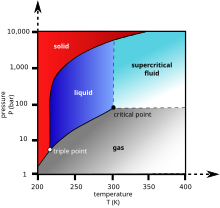
- For more details on this topic, see Carbon dioxide (data page).Carbon dioxide is a colourless, odorless gas. When inhaled at concentrations much higher than usual atmospheric levels, it can produce a sour taste in the mouth and a stinging sensation in the nose and throat. These effects result from the gas dissolving in the mucous membranes and saliva, forming a weak solution of carbonic acid. This sensation can also occur during an attempt to stifle a burp after drinking a carbonated beverage. Amounts above 5,000 ppm are considered very unhealthy, and those above about 50,000 ppm (equal to 5% by volume) are considered dangerous to animal life.[3]
At standard temperature and pressure, the density of carbon dioxide is around 1.98 kg/m3, about 1.5 times that of air. The carbon dioxide molecule (O=C=O) contains two double bonds and has a linear shape. It has no electrical dipole, and as it is fully oxidized, it is moderately reactive and is non-flammable, but will support the combustion of metals such as magnesium.
At −78.51 °C or −109.3 °F, carbon dioxide changes directly from a solid phase to a gaseous phase through sublimation, or from gaseous to solid through deposition. Solid carbon dioxide is normally called "dry ice", a generic trademark. It was first observed in 1825 by the French chemist Charles Thilorier. Dry ice is commonly used as a cooling agent, and it is relatively inexpensive. A convenient property for this purpose is that solid carbon dioxide sublimes directly into the gas phase leaving no liquid. It can often be found in grocery stores and laboratories, and it is also used in the shipping industry. The largest non-cooling use for dry ice is blast cleaning.
Liquid carbon dioxide forms only at pressures above 5.1 atm; the triple point of carbon dioxide is about 518 kPa at −56.6 °C (See phase diagram, above). The critical point is 7.38 MPa at 31.1 °C.[4]
An alternative form of solid carbon dioxide, an amorphous glass-like form, is possible, although not at atmospheric pressure.[5] This form of glass, called carbonia, was produced by supercooling heated CO2 at extreme pressure (40–48 GPa or about 400,000 atmospheres) in a diamond anvil. This discovery confirmed the theory that carbon dioxide could exist in a glass state similar to other members of its elemental family, like silicon (silica glass) and germanium. Unlike silica and germania glasses, however, carbonia glass is not stable at normal pressures and reverts back to gas when pressure is released.
- See also: Supercritical carbon dioxide and dry ice
[edit] History of human understanding
Carbon dioxide was one of the first gases to be described as a substance distinct from air. In the seventeenth century, the Flemish chemist Jan Baptist van Helmont observed that when he burned charcoal in a closed vessel, the mass of the resulting ash was much less than that of the original charcoal. His interpretation was that the rest of the charcoal had been transmuted into an invisible substance he termed a "gas" or "wild spirit" (spiritus sylvestre).
The properties of carbon dioxide were studied more thoroughly in the 1750s by the Scottish physician Joseph Black. He found that limestone (calcium carbonate) could be heated or treated with acids to yield a gas he called "fixed air." He observed that the fixed air was denser than air and did not support either flame or animal life. Black also found that when bubbled through an aqueous solution of lime (calcium hydroxide), it would precipitate calcium carbonate. He used this phenomenon to illustrate that carbon dioxide is produced by animal respiration and microbial fermentation. In 1772, English chemist Joseph Priestley published a paper entitled Impregnating Water with Fixed Air in which he described a process of dripping sulfuric acid (or oil of vitriol as Priestley knew it) on chalk in order to produce carbon dioxide, and forcing the gas to dissolve by agitating a bowl of water in contact with the gas.[6]
Carbon dioxide was first liquefied (at elevated pressures) in 1823 by Humphry Davy and Michael Faraday.[7] The earliest description of solid carbon dioxide was given by Charles Thilorier, who in 1834 opened a pressurized container of liquid carbon dioxide, only to find that the cooling produced by the rapid evaporation of the liquid yielded a "snow" of solid CO2.[8]
[edit] Isolation and production
Carbon dioxide may be obtained from air distillation. However, this yields only very small quantities of CO2. A large variety of chemical reactions yield carbon dioxide, such as the reaction between most acids and most metal carbonates. For example, the reaction between hydrochloric acid and calcium carbonate (limestone or chalk) is depicted below:
- 2 HCl + CaCO3 → CaCl2 + H2CO3
The H2CO3 then decomposes to water and CO2. Such reactions are accompanied by foaming or bubbling, or both. In industry such reactions are widespread because they can be used to neutralize waste acid streams.
The production of quicklime (CaO) a chemical that has widespread use, from limestone by heating at about 850 °C also produces CO2:
- CaCO3 → CaO + CO2
The combustion of all carbon containing fuels, such as methane (natural gas), petroleum distillates (gasoline, diesel, kerosene, propane), but also of coal and wood, will yield carbon dioxide and, in most cases, water. As an example the chemical reaction between methane and oxygen is given below.
- CH4 + 2 O2 → CO2 + 2 H2O
Iron is reduced from its own oxides with coke in a blast furnace, producing pig iron and carbon dioxide:
- 2 Fe2O3 + 3 C → 4 Fe + 3 CO2
Yeast metabolizes sugar to produce carbon dioxide and ethanol, also known as alcohol, in the production of wines, beers and other spirits, but also in the production of bioethanol:
- C6H12O6 → 2 CO2 + 2 C2H5OH
All aerobic organisms produce CO2 when they oxidize carbohydrates, fatty acids, and proteins in the mitochondria of cells. The large number of reactions involved are exceedingly complex and not described easily. Refer to (cellular respiration, anaerobic respiration and photosynthesis). Photoautotrophs (i.e. plants, cyanobacteria) use another modus operandi: Plants absorb CO2 from the air, and, together with water, react it to form carbohydrates:
- nCO2 + nH2O → (CH2O)n + nO2
Carbon dioxide is soluble in water, in which it spontaneously interconverts between CO2 and H2CO3 (carbonic acid). The relative concentrations of CO2, H2CO3, and the deprotonated forms HCO3− (bicarbonate) and CO32−(carbonate) depend on the pH. In neutral or slightly alkaline water (pH > 6.5), the bicarbonate form predominates (>50%) becoming the most prevalent (>95%) at the pH of seawater, while in very alkaline water (pH > 10.4) the predominant (>50%) form is carbonate. The bicarbonate and carbonate forms are very soluble, such that air-equilibrated ocean water (mildly alkaline with typical pH = 8.2 – 8.5) contains about 120 mg of bicarbonate per liter.
[edit] Uses
Carbon dioxide is used by the food industry, the oil industry, and the chemical industry.[9] It is used in many consumer products that require pressurized gas because it is inexpensive and nonflammable, and because it undergoes a phase transition from gas to liquid at room temperature at an attainable pressure of approximately 60 bar (870 psi, 59 atm), allowing far more carbon dioxide to fit in a given container than otherwise would. Life jackets often contain canisters of pressured carbon dioxide for quick inflation. Aluminum capsules are also sold as supplies of compressed gas for airguns, paintball markers, for inflating bicycle tires, and for making seltzer. Rapid vaporization of liquid carbon dioxide is used for blasting in coal mines. High concentrations of carbon dioxide can also be used to kill pests, such as the Common Clothes Moth.
[edit] Drinks
Carbon dioxide is used to produce carbonated soft drinks and soda water. Traditionally, the carbonation in beer and sparkling wine comes about through natural fermentation, but some manufacturers carbonate these drinks artificially.
[edit] Foods
A candy called Pop Rocks is pressurized with carbon dioxide gas at about 40 bar (600 psi). When placed in the mouth, it dissolves (just like other hard candy) and releases the gas bubbles with an audible pop.
Leavening agents produce carbon dioxide to cause dough to rise. Baker's yeast produces carbon dioxide by fermentation of sugars within the dough, while chemical leaveners such as baking powder and baking soda release carbon dioxide when heated or if exposed to acids.
[edit] Pneumatic systems
Carbon dioxide is the most commonly used compressed gas for pneumatic systems in portable pressure tools and combat robots.
[edit] Fire extinguisher
Carbon dioxide extinguishes flames, and some fire extinguishers, especially those designed for electrical fires, contain liquid carbon dioxide under pressure. Carbon dioxide has also been widely used as an extinguishing agent in fixed fire protection systems for total flooding of a protected space, (National Fire Protection Association Code 12). International Maritime Organisation standards also recognise carbon dioxide systems for fire protection of ship holds and engine rooms. Carbon dioxide based fire protection systems have been linked to several deaths. A review of CO2 systems (Carbon Dioxide as a Fire Suppressant: Examining the Risks, US EPA) identified 51 incidents between 1975 and the date of the report, causing 72 deaths and 145 injuries.
[edit] Welding
Carbon dioxide also finds use as an atmosphere for welding, although in the welding arc, it reacts to oxidize most metals. Use in the automotive industry is common despite significant evidence that welds made in carbon dioxide are brittler than those made in more inert atmospheres, and that such weld joints deteriorate over time because of the formation of carbonic acid. It is used as a welding gas primarily because it is much less expensive than more inert gases such as argon or helium.
[edit] Caffeine removal
Liquid carbon dioxide is a good solvent for many lipophilic organic compounds, and is used to remove caffeine from coffee. First, the green coffee beans are soaked in water. The beans are placed in the top of a column seventy feet (21 m) high. Then super-pressurized carbon dioxide in fluid form at about 93 degrees Celsius enters at the bottom of the column. The caffeine diffuses out of the beans and into the carbon dioxide.
[edit] Pharmaceutical and other chemical processing
Carbon dioxide has begun to attract attention in the pharmaceutical and other chemical processing industries as a less toxic alternative to more traditional solvents such as organochlorides. It's used by some dry cleaners for this reason. (See green chemistry.)
In the chemical industry, carbon dioxide is used for the production of urea, carbonates and bicarbonates, and sodium salicylate.
[edit] Biological applications
Plants require carbon dioxide to conduct photosynthesis, and greenhouses may enrich their atmospheres with additional CO2 to boost plant growth, since its low present-day atmosphere concentration is just above the "suffocation" level for green plants. A photosynthesis-related drop in carbon dioxide concentration in a greenhouse compartment can kill green plants. At high concentrations, carbon dioxide is toxic to animal life, so raising the concentration to 10,000 ppm (1%) for several hours can eliminate pests such as whiteflies and spider mites in a greenhouse.
It has been proposed that carbon dioxide from power generation be bubbled into ponds to grow algae that could then be converted into biodiesel fuel.[10] Carbon dioxide is already increasingly used in greenhouses as the main carbon source for Spirulina algae. In medicine, up to 5% carbon dioxide is added to pure oxygen for stimulation of breathing after apnea and to stabilize the O2/CO2 balance in blood.
[edit] Lasers
| Please help improve this article or section by expanding it. Further information might be found on the talk page. (December 2008) |
A common type of industrial gas laser is the carbon dioxide laser. The electronic transitions available in carbon dioxide produce laser light relatively efficiently. A working laser can be made with a variety of gas pressures and compositions, even with pure gas, allowing students to experiment with the effect of gas mixtures on laser performance. This same property makes commercially-made carbon dioxide lasers relatively inexpensive for the power available.
[edit] Polymers and plastics
| Please help improve this article or section by expanding it. Further information might be found on the talk page. (December 2008) |
Carbon dioxide can also be combined with limonene oxide from orange peels or other epoxides to create polymers and plastics.[11]
[edit] Oil recovery
| Please help improve this article or section by expanding it. Further information might be found on the talk page. (December 2008) |
Carbon dioxide is used in enhanced oil recovery where it is injected into or adjacent to producing oil wells, usually under supercritical conditions. It acts as both a pressurizing agent and, when dissolved into the underground crude oil, significantly reduces its viscosity, enabling the oil to flow more rapidly through the earth to the removal well.[12] In mature oil fields, extensive pipe networks are used to carry the carbon dioxide to the injection points.
[edit] As refrigerants
Liquid and solid carbon dioxide are important refrigerants, especially in the food industry, where they are employed during the transportation and storage of ice cream and other frozen foods. Solid carbon dioxide is called "dry ice" and is used for small shipments where refrigeration equipment is not practical.
Liquid carbon dioxide (industry nomenclature R744 / R-744) was used as a refrigerant prior to the discovery of R-12. Its physical properties are highly favorable for cooling, refrigeration, and heating purposes, having a high volumetric cooling capacity. Due to their operation at pressures of up to 130 bars, CO2 systems require highly resistant components that have been already developed to serial production in many sectors.
| This article or section contains weasel words, vague phrasing that often accompanies biased or unverifiable information. Such statements should be clarified or removed. (December 2008) |
Its environmental advantages (GWP of 1, non-ozone depleting, non-toxic, non-flammable) could make it the future working fluid to replace current HFCs in cars, supermarkets, hot water heat pumps, among others. Some applications: Coca-Cola has fielded CO2-based beverage coolers and the US Army is interested in CO2 refrigeration and heating technology.[13][14]
By the end of 2007, the global car industry is expected to decide on the next-generation refrigerant in car air conditioning. CO2 is one discussed option.(see The Cool War)
[edit] Coal bed methane recovery
| Please help improve this section by expanding it. Further information might be found on the talk page. (December 2008) |
In enhanced coal bed methane recovery, carbon dioxide is pumped into the coal seam to displace methane.[15]
[edit] Wine making
Carbon dioxide in the form of dry ice is often used in the wine making process to cool down bunches of grapes quickly after picking to help prevent spontaneous fermentation by wild yeasts. The advantage of using dry ice over regular water ice is that it cools the grapes without adding any additional water that may decrease the sugar concentration in the grape must, and therefore also decrease the alcohol concentration in the finished wine.
Dry ice is also used during the cold soak phase of the wine making process to keep grapes cool. The carbon dioxide gas that results from the sublimation of the dry ice tends to settle to the bottom of tanks because it is heavier than regular air. The settled carbon dioxide gas creates an hyoxic environment which helps to prevent bacteria from growing on the grapes until it is time to start the fermentation with the desired strain of yeast.
Carbon dioxide is also used to create a hypoxic environment for carbonic maceration, the process used to produce Beaujolais wine.
Carbon dioxide is sometimes used to top up wine bottles or other storage vessels such as barrels to prevent oxidation, though it has the problem that it can dissolve into the wine, making a previously still wine slightly fizzy. For this reason, other gasses such as nitrogen or argon are preferred for this process by professional wine makers.
[edit] Dry Cleaning
Carbon dioxide in its liquid state is increasingly being used as a more environmentally responsible solvent for dry cleaning.[16] It is also used as a rinse and drying agent in dry cleaning processes that use a more traditional solvent for the cleaning step.
[edit] In the Earth's atmosphere
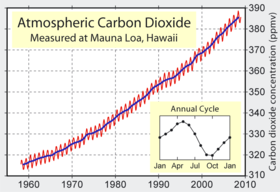
Carbon dioxide in earth's atmosphere is considered a trace gas currently occurring at an average concentration of about 385 parts per million by volume or 582 parts per million by mass.[17] The mass of the Earth atmosphere is 5.14×1018 kg [18], so the total mass of atmospheric carbon dioxide is 3.0×1015 kg (3,000 gigatonnes). Atmospheric concentrations of carbon dioxide fluctuate slightly with the change of the seasons, driven primarily by seasonal plant growth in the Northern Hemisphere. Concentrations of carbon dioxide fall during the northern spring and summer as plants consume the gas, and rise during the northern autumn and winter as plants go dormant, die and decay (see graph at right). Concentrations also vary considerably on a regional basis: in urban areas it is generally higher and indoors it can reach 10 times the background atmospheric concentration.
Carbon dioxide is a greenhouse gas. See greenhouse effect for more.

Due to human activities such as the combustion of fossil fuels and deforestation, the concentration of atmospheric carbon dioxide has increased by about 35% since the beginning of the age of industrialization.[20] In 1999, 2,244,804,000 (=~2.2×109) metric tons of CO2 were produced in the U.S. as a result of electric energy generation. This is an output rate of 0.6083 kg (1.341 pounds) per kWh.[21]
Five hundred million years ago carbon dioxide was 20 times more prevalent than today, decreasing to 4–5 times during the Jurassic period and then maintained a slow decline until the industrial revolution, with a particularly swift reduction occurring 49 million years ago.[22][23]
Up to 40% of the gas emitted by some volcanoes during subaerial volcanic eruptions is carbon dioxide.[24] According to the best estimates, volcanoes release about 130-230 million tonnes (145-255 million tons) of CO2 into the atmosphere each year. Carbon dioxide is also produced by hot springs such as those at the Bossoleto site near Rapolano Terme in Tuscany, Italy. Here, in a bowl-shaped depression of about 100 m diameter, local concentrations of CO2 rise to above 75% overnight, sufficient to kill insects and small animals, but warm rapidly when sunlit and disperse by convection during the day[25] Locally high concentrations of CO2, produced by disturbance of deep lake water saturated with CO2 are thought to have caused 37 fatalities at Lake Monoun, Cameroon in 1984 and 1700 casualties at Lake Nyos, Cameroon in 1986.[26] However, emissions of CO2 by human activities are currently more than 130 times greater than the quantity emitted by volcanoes, amounting to about 27 billion tonnes per year.[27]
[edit] In the oceans
There is about 50 times as much carbon dissolved in the oceans in the form of CO2 and CO2 hydration products as exists in the atmosphere. The oceans act as an enormous carbon sink, having "absorbed about one-third of all human-generated CO2 emissions to date."[28] Generally, gas solubility decreases as water temperature increases. Accordingly the ability of the oceans to absorb carbon dioxide from the atmosphere decreases as ocean temperatures rise.
Most of the CO2 taken up by the ocean forms carbonic acid. Some is consumed in photosynthesis by organisms in the water, and a small proportion of that sinks and leaves the carbon cycle. There is considerable concern that as a result of increased CO2 in the atmosphere the acidity of seawater has been increasing and may adversely affect organisms living in the water. In particular, with increasing acidity, the availability of carbonates for forming shells decreases.[29]
[edit] Biological role
Carbon dioxide is an end product in organisms that obtain energy from breaking down sugars, fats and amino acids with oxygen as part of their metabolism, in a process known as cellular respiration. This includes all plants, animals, many fungi and some bacteria. In higher animals, the carbon dioxide travels in the blood from the body's tissues to the lungs where it is exhaled. In plants using photosynthesis, carbon dioxide is absorbed from the atmosphere.
[edit] Role in photosynthesis
Plants remove carbon dioxide from the atmosphere by photosynthesis, also called carbon assimilation, which uses light energy to produce organic plant materials (cellulose) by combining carbon dioxide and water. Free oxygen is released as gas from the decomposition of water molecules, while the hydrogen is split into its protons and electrons and used to generate chemical energy via photophosphorylation. This energy is required for the fixation of carbon dioxide in the Calvin cycle to form sugars. These sugars can then be used for growth within the plant through respiration.
Even when vented, carbon dioxide must be introduced into greenhouses to maintain plant growth, as the concentration of carbon dioxide can fall during daylight hours to as low as 200 ppm. Plants can potentially grow up to 50 percent faster in concentrations of 1,000 ppm CO2 when compared with ambient conditions.[30]
Plants also emit CO2 during respiration, so it is only during growth stages that plants are net absorbers. For example a growing forest will absorb many tons of CO2 each year, however a mature forest will produce as much CO2 from respiration and decomposition of dead specimens (e.g. fallen branches) as used in biosynthesis in growing plants.[31] Regardless of this, mature forests are still valuable carbon sinks, helping maintain balance in the Earth's atmosphere. Additionally, and crucially to life on earth, phytoplankton photosynthesis absorbs dissolved CO2 in the upper ocean and thereby promotes the absorption of CO2 from the atmosphere.[32]
[edit] Toxicity
Carbon dioxide content in fresh air (averaged between sea-level and 10 hPa level, i.e. about 30 km altitude) varies between 0.036% (360 ppm) and 0.039% (390 ppm), depending on the location (see graphical map of CO2).
According to the Australian Maritime Safety Authority, "Prolonged exposure to moderate concentrations can cause acidosis and adverse effects on calcium phosphorus metabolism resulting in increased calcium deposits in soft tissue. Carbon dioxide is toxic to the heart and causes diminished contractile force. At concentrations of three per cent by volume in air, it is mildly narcotic and causes increased blood pressure and pulse rate, and causes reduced hearing. At concentrations of about five per cent by volume it causes stimulation of the respiratory centre, dizziness, confusion and difficulty in breathing accompanied by headache and shortness of breath. At about eight per cent concentration it causes headache, sweating, dim vision, tremor and loss of consciousness after exposure for between five and ten minutes." [33]
A natural disaster linked to CO2 intoxication occurred during the limnic eruptions in the CO2-rich lakes of Monoun and Nyos in the Okun range of North-West Cameroon: the gas was brutally expelled from the mountain lakes and leaked into the surrounding valleys, killing most animal forms. During the Lake Nyos tragedy of 1986, 1700 villagers and 3500 livestock died.[34]
Due to the health risks associated with carbon dioxide exposure, the U.S. Occupational Safety and Health Administration says that average exposure for healthy adults during an eight-hour work day should not exceed 5,000 ppm (0.5%). The maximum safe level for infants, children, the elderly and individuals with cardio-pulmonary health issues is significantly less. For short-term (under ten minutes) exposure, the U.S. National Institute for Occupational Safety and Health (NIOSH) and American Conference of Government Industrial Hygienists (ACGIH) limit is 30,000 ppm (3%). NIOSH also states that carbon dioxide concentrations exceeding 4% are immediately dangerous to life and health. [35]
Adaptation to increased levels of CO2 occurs in humans. Continuous inhalation of CO2 can be tolerated at three percent inspired concentrations for at least one month and four percent inspired concentrations for over a week. It was suggested that 2.0 percent inspired concentrations could be used for closed air spaces (ex. Submarine) since the adaptation is physiological and reversible. Decrement in performance or in normal physical activity does not happen at this level.[36][37]
These figures are valid for pure carbon dioxide. In indoor spaces occupied by people the carbon dioxide concentration will reach higher levels than in pure outdoor air. Concentrations higher than 1,000 ppm will cause discomfort in more than 20% of occupants, and the discomfort will increase with increasing CO2 concentration. The discomfort will be caused by various gases coming from human respiration and perspiration, and not by CO2 alone. At 2,000 ppm the majority of occupants will feel a significant degree of discomfort, and many will develop nausea and headaches. The CO2 concentration between 300 and 2,500 ppm is used as an indicator of indoor air quality.
Acute carbon dioxide toxicity is sometimes known by the names given to it by miners: blackdamp (also called choke damp or stythe). Miners would try to alert themselves to dangerous levels of carbon dioxide in a mine shaft by bringing a caged canary with them as they worked. The canary would inevitably die before CO2 reached levels toxic to people. (The canary would also indicate dangerous levels of methane and other gases by the same principle.)
Carbon dioxide ppm levels (CDPL) are a surrogate for measuring indoor pollutants that may cause occupants to grow drowsy, get headaches, or function at lower activity levels. To eliminate most Indoor Air Quality complaints, total indoor CDPL must be reduced to below 600. NIOSH considers that indoor air concentrations that exceed 1,000 are a marker suggesting inadequate ventilation. ASHRAE recommends they not exceed 1,000 inside a space.
[edit] Human physiology
- See also: Arterial blood gas
CO2 is carried in blood in three different ways. (The exact percentages vary depending whether it is arterial or venous blood).
- Most of it (about 70% – 80%) is converted to bicarbonate ions HCO3− by the enzyme carbonic anhydrase in the red blood cells,[38] by the reaction CO2 + H2O → H2CO3 → H+ + HCO3−.
- 5% – 10% is bound to hemoglobin as carbamino compounds[38]
Haemoglobin, the main oxygen-carrying molecule in red blood cells, carries both oxygen and carbon dioxide. However, the CO2 bound to hemoglobin does not bind to the same site as oxygen. Instead, it combines with the N-terminal groups on the four globin chains. However, because of allosteric effects on the hemoglobin molecule, the binding of CO2 decreases the amount of oxygen that is bound for a given partial pressure of oxygen. The decreased binding to carbon dioxide in the blood due to increased oxygen levels is known as the Haldane Effect, and is important in the transport of carbon dioxide from the tissues to the lungs. Conversely, a rise in the partial pressure of CO2 or a lower pH will cause offloading of oxygen from hemoglobin, which is known as the Bohr Effect.
Carbon dioxide is one of the mediators of local autoregulation of blood supply. If its levels are high, the capillaries expand to allow a greater blood flow to that tissue.
Bicarbonate ions are crucial for regulating blood pH. A person's breathing rate influences the level of CO2 in their blood. Breathing that is too slow or shallow causes respiratory acidosis, while breathing that is too rapid leads to hyperventilation, which may cause respiratory alkalosis.
Although the body requires oxygen for metabolism, low oxygen levels do not stimulate breathing. Rather, breathing is stimulated by higher carbon dioxide levels. As a result, breathing low-pressure air or a gas mixture with no oxygen at all (such as pure nitrogen) can lead to loss of consciousness without ever experiencing air hunger. This is especially perilous for high-altitude fighter pilots. It is also why flight attendants instruct passengers, in case of loss of cabin pressure, to apply the oxygen mask to themselves first before helping others — otherwise one risks going unconscious.[38]
Typically the gas we exhale is about 4% to 5% carbon dioxide and 4% to 5% less oxygen than was inhaled.
According to a study by the United States Department of Agriculture, an average person's respiration generates approximately 450 liters (roughly 900 grams) of carbon dioxide per day

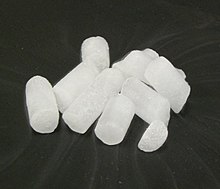
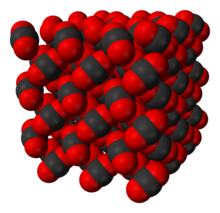
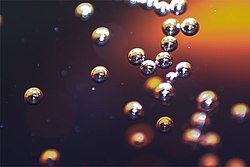
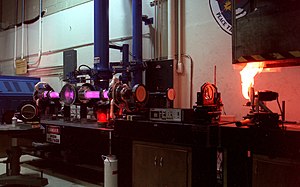
No comments:
Post a Comment